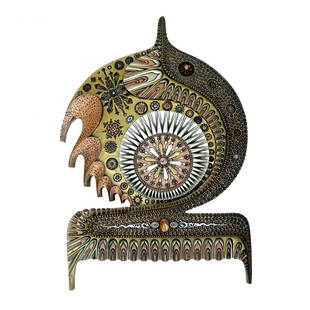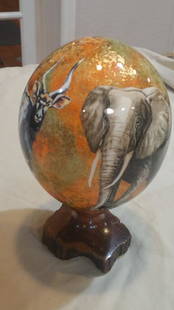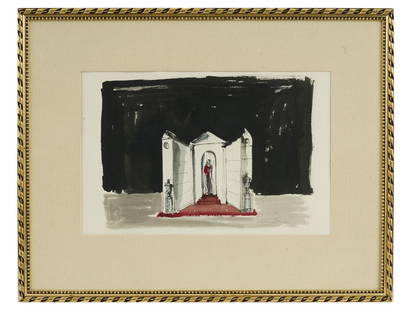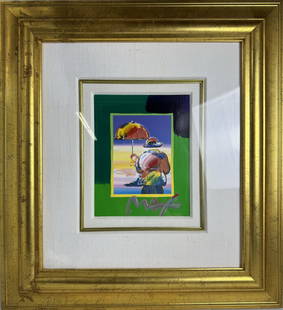
Penelope Siopis (South African, born 1953) Cape of Good Hope: A History Painting, 1990 (framed)
Similar Sale History
View More Items in Mixed Media & CollagesRelated Mixed Media & Collages
More Items in Mixed Media & Collages
View MoreRecommended Art
View More


Item Details
Description
Penelope Siopis (South African, born 1953)
Cape of Good Hope: A History Painting, 1990
signed 'Siopis'(lower left)
oil and mixed media on board
164 x 156cm (64 9/16 x 61 7/16in).
(framed)
Footnotes:
Provenance
A private collection.
Exhibited
Museum of Modern Art, Oxford in association with the Zabalaza Festival in London, Art from South Africa (June-September 1990)
British Museum, London, Southern Africa, the art of a nation, (October 2016- February 2017).
Literature
Polly Savage, Making Art in Africa 1960-2010, (Surrey: Lund Humphries, 2014), pp, 210-211. (illustrated)
John Giblin & Chris Spring, South Africa, the art of a nation, (London: Thames & Hudson and The British Museum, 2017), pp, 59-62. (illustrated)
David Elliot, art from South Arica, Museum of Oxford, Exhibition catalogue (Oxford: Museum of Modern Art, Oxford and Thames & Hudson, 1990), pp, 7-9. (illustrated)
Created during a volatile and unpredictable time during the apartheid in South Africa, during the 1980s, Penny Siopis depicted the present lot, Cape of Good Hope (1989). This painting displays a nude young woman grasps a blue curtain with an ambiguity to whether she is holding it up or pulling it down. Attached to the curtain are images reproduced from The Landing of Jan Van Riebeeck (1619-77) 6th April 1652 from Charles Bell's 1850 painting. These small images detail Van Riebeeck's arrival to the Cape marking the first steps that would evolve into colonisation that would have led to the eventual present day political turmoil that Siopis and the people of South Africa were experiencing. His arrival is now marked by Castle of Good Hope built by people who had been enslaved by the Dutch East India Company. Van Riebeeck was working for the Dutch East India Company between 1666 and 1679. This castle acted as the Dutch base in the Cape, enabling further voyagers to replenish their supplies as they made their way down the coast and towards Indonesia. There is a sense here of ownership as the main subject of the painting gives the impression that she is about to catalyse a change by pulling the curtain in any way she chooses.
'The tattoos [on her back]are [details of] reproductions of abolitionist engravings of slaves, so while the title and these little labels [attached to the drapes] reference South African history, these markings on her body reference colonial history much more broadly, particularly slavery. On her face are small fragments of texts, which are taken from Saarjie Baartman's baptismal certificate and death certificate [sourced from the Musee de l'Homme], and the labels pinned to the cloth are [the same] image repeated of [a South African history painting] showing the arrival of [the so-called founding father] Van Riebeeck at the Cape and his encounter with indigenous people. So it's also meant to be a [critical] history painting.'(Penelope Siopis in conversation with Polly Savage from John Giblin & Chris Spring, South Africa, the art of a nation, (London: Thames & Hudson and The British Museum, 2017), p. 59)
The significance of the main figurative subject's body holds great relevance within this work. Siopis has herself stated 'The idea that she's a young woman is important because I wanted defiance in [the painting].'(Polly Savage, Making Art in Africa 1960-2010, (Surrey: Lund Humphries, 2014), p, 211.). Here, Siopis outlines why the presence of the female figure is metaphorically significant in relation to the context of the work, however, her body also acts as a vessel to present multiple bodies, executed by Siopis through multiple layers of paint. The clustering and intertwining of these small bodies are reminiscent of Hieronymus Bosch's (1450-1516) depictions such as in The Garden of Earthly Delights (1460-1510) who also championed imagery of free-flowing connectivity that also gave a chaotic energy within the bodies he painted. While in practise, the depiction of many bodies holds resemblance, Siopis's motive is to communicate a physical history rather than metaphysical in her terms 'inscribed or tattooed with history.'(Polly Savage, Making Art in Africa 1960-2010, (Surrey: Lund Humphries, 2014), p, 211.).
This concept of tattooing to Siopis held gravitas, in that image making and history physically became part of one's skin imbedded into the human's existence of whom the history had impacted. Indeed, the skin acts as the membrane that separates the external impacts that effect the inner feelings.
Bibliography
'Colonial Voyage- The website dedicated to the Colonial History' archived from the original 25 July 2010 (https://web.archive.org/web/20100725115547/http://www.colonialvoyage.com/africa/eng/southafrica/capetown/castleofgoodhope.html)
Penelope Siopis in Polly Savage, Making Art in Africa 1960-2010, (Surrey: Lund Humphries, 2014)
Cape of Good Hope: A History Painting, 1990
signed 'Siopis'(lower left)
oil and mixed media on board
164 x 156cm (64 9/16 x 61 7/16in).
(framed)
Footnotes:
Provenance
A private collection.
Exhibited
Museum of Modern Art, Oxford in association with the Zabalaza Festival in London, Art from South Africa (June-September 1990)
British Museum, London, Southern Africa, the art of a nation, (October 2016- February 2017).
Literature
Polly Savage, Making Art in Africa 1960-2010, (Surrey: Lund Humphries, 2014), pp, 210-211. (illustrated)
John Giblin & Chris Spring, South Africa, the art of a nation, (London: Thames & Hudson and The British Museum, 2017), pp, 59-62. (illustrated)
David Elliot, art from South Arica, Museum of Oxford, Exhibition catalogue (Oxford: Museum of Modern Art, Oxford and Thames & Hudson, 1990), pp, 7-9. (illustrated)
Created during a volatile and unpredictable time during the apartheid in South Africa, during the 1980s, Penny Siopis depicted the present lot, Cape of Good Hope (1989). This painting displays a nude young woman grasps a blue curtain with an ambiguity to whether she is holding it up or pulling it down. Attached to the curtain are images reproduced from The Landing of Jan Van Riebeeck (1619-77) 6th April 1652 from Charles Bell's 1850 painting. These small images detail Van Riebeeck's arrival to the Cape marking the first steps that would evolve into colonisation that would have led to the eventual present day political turmoil that Siopis and the people of South Africa were experiencing. His arrival is now marked by Castle of Good Hope built by people who had been enslaved by the Dutch East India Company. Van Riebeeck was working for the Dutch East India Company between 1666 and 1679. This castle acted as the Dutch base in the Cape, enabling further voyagers to replenish their supplies as they made their way down the coast and towards Indonesia. There is a sense here of ownership as the main subject of the painting gives the impression that she is about to catalyse a change by pulling the curtain in any way she chooses.
'The tattoos [on her back]are [details of] reproductions of abolitionist engravings of slaves, so while the title and these little labels [attached to the drapes] reference South African history, these markings on her body reference colonial history much more broadly, particularly slavery. On her face are small fragments of texts, which are taken from Saarjie Baartman's baptismal certificate and death certificate [sourced from the Musee de l'Homme], and the labels pinned to the cloth are [the same] image repeated of [a South African history painting] showing the arrival of [the so-called founding father] Van Riebeeck at the Cape and his encounter with indigenous people. So it's also meant to be a [critical] history painting.'(Penelope Siopis in conversation with Polly Savage from John Giblin & Chris Spring, South Africa, the art of a nation, (London: Thames & Hudson and The British Museum, 2017), p. 59)
The significance of the main figurative subject's body holds great relevance within this work. Siopis has herself stated 'The idea that she's a young woman is important because I wanted defiance in [the painting].'(Polly Savage, Making Art in Africa 1960-2010, (Surrey: Lund Humphries, 2014), p, 211.). Here, Siopis outlines why the presence of the female figure is metaphorically significant in relation to the context of the work, however, her body also acts as a vessel to present multiple bodies, executed by Siopis through multiple layers of paint. The clustering and intertwining of these small bodies are reminiscent of Hieronymus Bosch's (1450-1516) depictions such as in The Garden of Earthly Delights (1460-1510) who also championed imagery of free-flowing connectivity that also gave a chaotic energy within the bodies he painted. While in practise, the depiction of many bodies holds resemblance, Siopis's motive is to communicate a physical history rather than metaphysical in her terms 'inscribed or tattooed with history.'(Polly Savage, Making Art in Africa 1960-2010, (Surrey: Lund Humphries, 2014), p, 211.).
This concept of tattooing to Siopis held gravitas, in that image making and history physically became part of one's skin imbedded into the human's existence of whom the history had impacted. Indeed, the skin acts as the membrane that separates the external impacts that effect the inner feelings.
Bibliography
'Colonial Voyage- The website dedicated to the Colonial History' archived from the original 25 July 2010 (https://web.archive.org/web/20100725115547/http://www.colonialvoyage.com/africa/eng/southafrica/capetown/castleofgoodhope.html)
Penelope Siopis in Polly Savage, Making Art in Africa 1960-2010, (Surrey: Lund Humphries, 2014)
Buyer's Premium
- 28% up to £40,000.00
- 27% up to £800,000.00
- 21% above £800,000.00
Penelope Siopis (South African, born 1953) Cape of Good Hope: A History Painting, 1990 (framed)
Estimate £50,000 - £80,000
Get approved to bid.
Shipping & Pickup Options
Item located in London, New Bond Street, ukSee Policy for Shipping
Payment

TOP









































![ARTIST UNKNOWN (American, 20th century). Pair of Paintings,...: ARTIST UNKNOWN (American, 20th century). Pair of Paintings, including “Hanged at a Thread / Appreso a un Filo.” [2009]. Both are mixed media on paper. Both signed at lower right corne](https://p1.liveauctioneers.com/928/330686/178765833_1_x.jpg?height=310&quality=70&version=1716992685)














![[ARTIST UNKNOWN] (American, 20th century). Rump Theatre, A ...: [ARTIST UNKNOWN] (American, 20th century). Rump Theatre, A Miniature Art Deco Theater Diorama. Not dated. Mixed media sculpture encased with glass. 30 h x 36 ¼ w x 31 ½” d. Diorama rec](https://p1.liveauctioneers.com/928/330686/178765526_1_x.jpg?height=310&quality=70&version=1716992685)













![Emilio Grau-Sala "Sur la Plage" Oil on Canvas: Emilio Grau-Sala (Spanish, 1911-1975), "Sur la Plage" [On The Beach], Oil on Canvas, 1958, signed "Grau Sala" lower right, signed, inscribed "Trouville", dated, and titled to verso. Image: 21.5" H x 2](https://p1.liveauctioneers.com/5649/328023/176731071_1_x.jpg?height=310&quality=70&version=1714409606)













